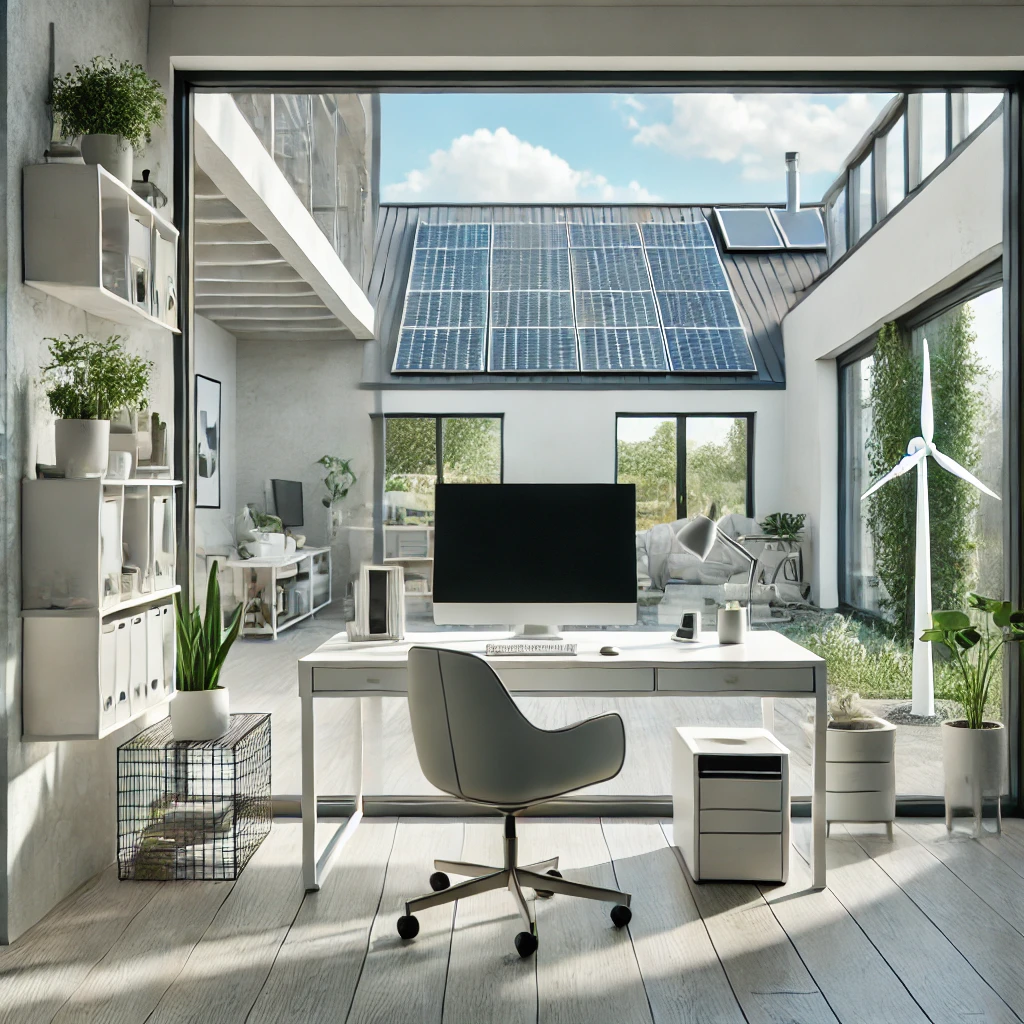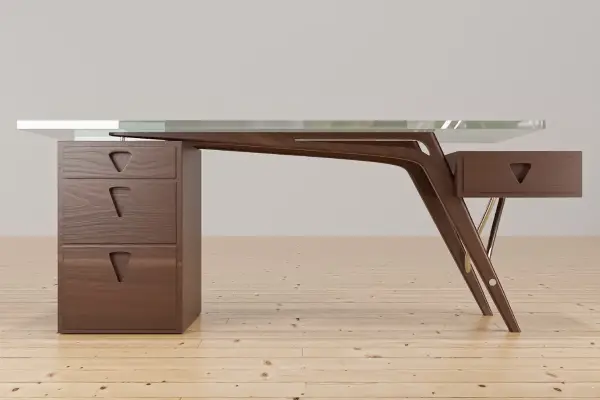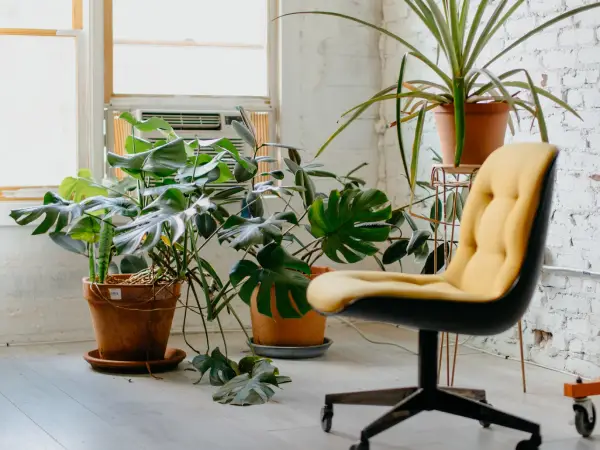Imagine walking into your office every morning to find a serene, clutter-free space that instantly puts you in a focused, productive mindset. The allure of a minimalist office is undeniable—less clutter means less distraction, allowing you to channel your energy into what truly matters. In today’s fast-paced world, where we’re constantly bombarded with information and stimuli, creating a minimalist workspace can be a game-changer for your productivity and overall well-being.
But minimalism isn’t just about getting rid of things; it’s about making deliberate choices that enhance functionality and foster a sense of calm. By carefully selecting a few essential pieces of furniture, you can transform your office into a haven of efficiency and style. A functional minimalist office doesn’t just look good—it works better. The right setup can significantly boost your productivity, reduce stress, and create an environment where creativity thrives.
In this article, we’ll guide you through the process of creating a functional minimalist office with limited furniture. From choosing the perfect desk and ergonomic chair to finding smart storage solutions and effective lighting, we’ll cover all the essentials. Whether you’re setting up a home office or revamping your workspace at the office, these tips will help you design a space that meets your needs while staying true to minimalist principles. Get ready to embrace the beauty of simplicity and create a workspace that inspires your best work.
The Philosophy of Minimalism in Office Design
Minimalism isn’t just a design trend—it’s a lifestyle choice that promotes simplicity, functionality, and intentionality. At its core, minimalism is about focusing on what truly matters and eliminating anything that distracts from that focus. When applied to office design, minimalism can transform your workspace into a serene, productive environment that enhances your ability to concentrate and work efficiently.
Definition of Minimalism: Understanding the Core Principles
Minimalism revolves around the idea of reducing excess and prioritizing essentials. It’s about creating spaces that are free from unnecessary clutter, allowing you to focus on the tasks at hand. In an office setting, this means selecting furniture and decor that serve a purpose and contribute to a streamlined, organized environment. Every item has a function, and everything has its place.
Benefits: Increased Productivity, Reduced Stress, and Aesthetic Appeal
Adopting a minimalist approach in your office comes with a myriad of benefits:
Increased Productivity: With fewer distractions and a cleaner environment, you can maintain focus on your work. A clutter-free space reduces the mental load of constantly processing visual noise, allowing you to concentrate better on important tasks.
Reduced Stress: Clutter can be a significant source of stress, leading to feelings of overwhelm and anxiety. By simplifying your workspace, you create a calm and peaceful atmosphere that helps to lower stress levels and promote a sense of well-being.
Aesthetic Appeal: Minimalist offices are often visually pleasing, with clean lines, neutral colors, and a sense of order. This aesthetic can be both calming and inspiring, making your office a place you enjoy spending time in.
Minimalism in Practice: How to Apply These Principles to Office Design
To create a minimalist office, start by evaluating your current setup. Identify items that are essential to your work and eliminate anything that doesn’t serve a clear purpose. This might involve decluttering your desk, organizing your storage, and removing unnecessary decor.
When selecting furniture, opt for pieces that are both functional and aesthetically pleasing. Choose a desk that offers ample workspace without being bulky, an ergonomic chair that supports good posture, and smart storage solutions that keep your essentials within easy reach. Remember, the goal is to create a space that is simple, efficient, and free from distractions.
Incorporate elements that enhance the functionality of your office without adding clutter. This might include effective lighting, comfortable seating, and a few carefully chosen accessories that inspire you. By adhering to the principles of minimalism, you can create an office that not only looks great but also supports your productivity and well-being.
In the next section, we’ll delve into the essential furniture pieces for a minimalist office, ensuring that every item you choose contributes to a functional and harmonious workspace.
Essential Furniture Pieces for a Minimalist Office
Creating a minimalist office doesn’t mean sacrificing functionality for simplicity. On the contrary, it’s about making smart choices and selecting furniture that serves multiple purposes while maintaining a clean, uncluttered look. By focusing on a few essential pieces, you can craft a workspace that is both efficient and aesthetically pleasing.
The Importance of Essentials: Focusing on Quality Over Quantity
In a minimalist office, every piece of furniture should earn its place by contributing to the functionality and harmony of the space. Instead of filling your office with numerous items, invest in high-quality essentials that offer durability and enhance your productivity. This approach not only creates a more organized environment but also supports a clearer, more focused mindset.
Key Pieces:
Desk: The Centerpiece of Productivity The desk is arguably the most critical piece of furniture in any office. It’s where the magic happens—where ideas are born, plans are executed, and goals are achieved. For a minimalist office, choose a desk that is sleek, functional, and proportionate to your space. Look for designs that offer built-in storage or cable management to keep the surface clutter-free. Materials like wood, metal, or glass can add a touch of elegance while maintaining a simple aesthetic.
Chair: Comfort Meets Ergonomics A minimalist office prioritizes both style and comfort, especially when it comes to seating. An ergonomic chair is essential for maintaining good posture and preventing discomfort during long work hours. Opt for a chair with adjustable features—such as height, armrests, and lumbar support—to ensure it fits your body perfectly. The design should be clean and modern, complementing the overall minimalist vibe of your office.
Storage Solutions: Maximizing Space with Minimal Furniture Efficient storage is crucial in a minimalist office to keep your workspace tidy and organized. Instead of bulky cabinets, consider multifunctional storage solutions that blend seamlessly with your decor. Floating shelves, wall-mounted units, and under-desk drawers can provide ample space for your office essentials without overwhelming the room. These solutions not only save space but also maintain the clean lines and open feel that are hallmarks of minimalist design.
Lighting: Functional and Stylish Lighting Options Good lighting is vital for creating a productive work environment. In a minimalist office, lighting should be both functional and stylish. Natural light is ideal, so position your desk near a window if possible. For artificial lighting, choose fixtures that offer bright, even illumination without harsh glare. Desk lamps with adjustable arms, minimalist pendant lights, or sleek floor lamps can enhance your workspace while adding a touch of modern elegance.
By focusing on these essential pieces, you can create a minimalist office that is not only functional but also a pleasure to work in. In the next section, we will explore how to choose the perfect desk for your minimalist office, ensuring it meets your needs and fits seamlessly into your space.
Choosing the Right Desk
Your desk is the heart of your office, the epicenter of productivity and creativity. In a minimalist office, the desk takes on an even greater significance, serving as a functional centerpiece while embodying the principles of simplicity and efficiency. Here’s how to choose the perfect desk for your minimalist workspace.
Size and Shape: Finding a Desk That Fits Your Space and Needs
When selecting a desk, consider the size and layout of your office. A desk that’s too large can dominate the room and disrupt the minimalist aesthetic, while one that’s too small may leave you feeling cramped. Measure your available space and choose a desk that provides ample workspace without overwhelming the room.
For smaller spaces, consider compact desks or corner desks that maximize floor space while offering sufficient room for your work essentials. If you have a bit more room to play with, a sleek, rectangular desk can provide a spacious surface for your projects without cluttering the space.
Material and Design: Opting for Minimalist Aesthetics
The materials and design of your desk play a significant role in achieving a minimalist look. Opt for clean lines, simple forms, and neutral colors that blend seamlessly with the rest of your office decor.
Wooden desks offer warmth and a natural feel, while metal or glass desks can add a modern, sleek touch. Consider materials that are both durable and easy to maintain, ensuring your desk remains a functional and attractive centerpiece for years to come.
Functionality: Features to Look for in a Minimalist Desk
In a minimalist office, functionality is key. Look for desks that offer built-in features to keep your workspace organized and efficient.
Built-In Storage: Drawers or shelves integrated into the desk design can provide convenient storage for your office supplies, helping you keep the surface clutter-free.
Cable Management: Desks with built-in cable management solutions can help you maintain a clean, organized look by keeping wires and cables out of sight.
Adjustability: Consider desks with adjustable heights, especially if you prefer to alternate between sitting and standing. Sit-stand desks can enhance your comfort and productivity by allowing you to change your posture throughout the day.
Multi-Functional Design: Some desks offer additional features like integrated lighting, hidden compartments, or convertible sections that can transform the desk into different configurations. These multi-functional designs can be particularly useful in a minimalist office where every piece of furniture must earn its place.
Personal Touch: While minimalism emphasizes simplicity, adding a personal touch can make your desk feel uniquely yours. Choose a desk that allows for subtle personalization, such as a specific wood grain or a unique leg design.
By carefully considering the size, material, and functionality of your desk, you can select a piece that not only meets your practical needs but also enhances the minimalist aesthetic of your office. In the next section, we’ll delve into the importance of choosing an ergonomic and stylish chair that complements your minimalist desk, ensuring comfort and support throughout your workday.
Ergonomic and Stylish Chairs
In the quest to create a minimalist office, the chair you choose plays a crucial role in ensuring both comfort and style. An ergonomic chair is essential for maintaining good posture and overall health, especially if you spend long hours at your desk. But in a minimalist workspace, it’s also important that your chair complements the clean, uncluttered aesthetic. Here’s how to find a chair that balances ergonomics and style.
Ergonomics: Importance of Support and Comfort
The cornerstone of an ergonomic chair is its ability to provide proper support and promote good posture. Look for chairs that offer:
Lumbar Support: A chair with adjustable lumbar support helps maintain the natural curve of your spine, reducing strain on your lower back.
Adjustable Features: Features such as seat height, armrests, and backrest angle should be adjustable to fit your body perfectly. This customization ensures that the chair supports you in all the right places, minimizing discomfort and fatigue.
Seat Depth and Cushioning: The seat should be deep enough to support your thighs without putting pressure on the back of your knees. Quality cushioning provides comfort without sacrificing support, ensuring you can work comfortably for extended periods.
Minimalist Design: Sleek and Simple Chair Options
While ergonomics are vital, the design of the chair should align with the minimalist aesthetic. Here are some key design elements to consider:
Clean Lines: Look for chairs with simple, clean lines that blend seamlessly with the rest of your office decor. Avoid overly ornate designs that can clutter the visual space.
Neutral Colors: Choose neutral colors like black, white, gray, or beige. These hues maintain a calm, cohesive look and complement most minimalist color schemes.
Slim Profiles: Opt for chairs with slim profiles that don’t dominate the room. Lightweight frames and minimalistic structures can enhance the open, airy feel of your workspace.
Multi-Functional Chairs: More Than Just Seating
In a minimalist office, furniture often needs to serve multiple purposes. Consider chairs that offer additional functionality:
Convertible Chairs: Some chairs can be adjusted or reconfigured to serve different functions, such as transforming from a standard office chair to a reclining lounge chair.
Built-In Storage: While rare, some innovative designs incorporate storage options, such as pockets or compartments, to keep your workspace tidy.
Portability: Lightweight, easy-to-move chairs can be beneficial in a flexible workspace where you might need to reconfigure the layout frequently.
Personalizing Your Chair: Subtle Touches for a Unique Look
Even in a minimalist office, there’s room for a bit of personal flair. Choose a chair that allows for subtle personalization:
Unique Textures: Consider materials with unique textures, such as mesh for breathability or smooth leather for a touch of luxury.
Distinctive Details: Look for chairs with distinctive but understated details, like stitching patterns or elegant base designs, that add character without overwhelming the minimalist aesthetic.
By prioritizing both ergonomics and design, you can find a chair that enhances the functionality and style of your minimalist office. A well-chosen chair not only supports your health and comfort but also contributes to the overall harmony of your workspace. In the next section, we’ll explore smart storage solutions that keep your office organized and efficient, further enhancing the minimalist environment.
Smart Storage Solutions
A minimalist office thrives on organization and efficiency, and smart storage solutions are the backbone of maintaining this order. In a space where every item should have a purpose and place, storage options that are both functional and stylish are essential. Here’s how to integrate smart storage solutions into your minimalist office to keep your workspace tidy and clutter-free.
Vertical vs. Horizontal Storage: Utilizing Wall Space
When space is at a premium, thinking vertically can make a world of difference. Wall-mounted storage solutions help free up floor space while keeping your essentials within easy reach.
Floating Shelves: These are perfect for displaying books, decor, and office supplies without taking up valuable floor space. Choose sleek, simple designs that blend with your office decor.
Wall-Mounted Cabinets: For items you prefer to keep out of sight, wall-mounted cabinets offer a clean, streamlined look while providing ample storage. Opt for cabinets with doors to maintain a clutter-free appearance.
Pegboards and Hooks: Pegboards can be customized with hooks and shelves to store and display various items. They are incredibly versatile and can be rearranged as needed, making them a dynamic addition to your minimalist office.
Multi-Functional Storage: Combining Storage with Other Uses
In a minimalist office, multifunctional furniture pieces are key to maximizing space and utility.
Storage Desks: Desks with built-in storage compartments, such as drawers or shelves, help keep your workspace clear of clutter. Look for desks that integrate storage without compromising on legroom or desk space.
Ottomans and Benches: Storage ottomans or benches can serve dual purposes as seating and storage. They provide a place to store less frequently used items while offering extra seating for guests.
Under-Desk Storage: Utilize the space under your desk with rolling carts or small cabinets that can be tucked away. These are ideal for storing office supplies, documents, and other essentials that need to be easily accessible.
Decluttering Tips: Keeping Only What You Need and Use
The essence of minimalism is to pare down to the essentials. Regularly decluttering your office ensures that it remains a serene and productive environment.
The One-Year Rule: If you haven’t used an item in the past year, it’s likely you don’t need it. Regularly review your belongings and remove anything that doesn’t serve a current purpose.
Categorize and Organize: Group similar items together and assign specific storage spots for each category. This makes it easier to find what you need and prevents the accumulation of random clutter.
Digital Over Physical: Wherever possible, digitize documents and records to reduce physical storage needs. Use cloud storage and digital filing systems to keep your office paper-free and organized.
Aesthetic Storage Solutions: Blending Function with Style
In a minimalist office, even storage solutions should contribute to the overall aesthetic.
Matching Containers: Use matching storage containers, boxes, or bins to create a cohesive look. Stick to neutral colors or materials that complement your office decor.
Hidden Storage: Incorporate hidden storage options, like furniture with concealed compartments, to maintain a clean, uncluttered appearance.
Minimalist Accessories: Choose simple, minimalist accessories like wire baskets or clear acrylic organizers. These keep items organized without adding visual clutter.
By integrating smart storage solutions into your minimalist office, you can create a space that is not only organized but also visually appealing. Efficient storage helps maintain the clean, open feel of a minimalist workspace, allowing you to focus on your work without distractions. In the next section, we’ll delve into the importance of effective lighting and how to choose the best lighting options for your minimalist office.
Effective Lighting for a Minimalist Office
Lighting is a crucial element in any office, impacting both aesthetics and functionality. In a minimalist workspace, effective lighting not only enhances productivity but also complements the clean, simple design. Here’s how to choose and implement the best lighting options for your minimalist office.
Natural Light: Maximizing Sunlight for Productivity and Well-Being
Natural light is the best light source for any workspace. It boosts mood, improves focus, and reduces eye strain. Position your desk near a window to take full advantage of natural light. If possible, arrange your office layout to maximize sunlight throughout the day.
Window Treatments: Choose light, sheer curtains or blinds that allow natural light to filter in while reducing glare. Avoid heavy, dark drapes that block sunlight and make the space feel enclosed.
Reflective Surfaces: Incorporate reflective surfaces like mirrors or glass furniture to bounce natural light around the room. This can brighten up your workspace and make it feel more open and airy.
Task Lighting: Focusing Light Where You Need It
Task lighting is essential for activities that require focused light, such as reading, writing, or computer work. In a minimalist office, task lighting should be functional and unobtrusive.
Desk Lamps: Choose a sleek, adjustable desk lamp that provides directed light without cluttering your workspace. Look for lamps with dimmable features to adjust brightness according to your needs.
Clip-On Lamps: If desk space is limited, consider clip-on lamps that can be attached to shelves or the edge of your desk. These provide focused light without taking up valuable desk space.
Under-Cabinet Lighting: For additional task lighting, install under-cabinet lights above your desk or work area. These lights are discreet and effective, providing illumination exactly where you need it.
Ambient Lighting: Creating a Warm and Inviting Atmosphere
Ambient lighting provides overall illumination for the room, creating a warm and inviting atmosphere. It should be soft and evenly distributed to prevent harsh shadows and glare.
Overhead Lighting: Choose minimalist ceiling fixtures that blend with your office decor. Recessed lighting or pendant lights with simple designs work well in minimalist spaces.
Floor Lamps: A sleek floor lamp can provide ambient light while adding a touch of style to your office. Position it in a corner or next to a seating area for balanced lighting.
Smart Lighting: Consider smart lighting solutions that allow you to control brightness and color temperature with a remote or app. This flexibility lets you adjust the lighting to suit different tasks and times of day.
Accent Lighting: Highlighting Key Areas
Accent lighting adds depth and dimension to your office, highlighting key areas or decorative elements. In a minimalist office, accent lighting should be subtle and purposeful.
LED Strips: Use LED strips to highlight shelves, artwork, or architectural features. They provide a soft, even glow that enhances the visual appeal without overwhelming the space.
Spotlights: Install small, adjustable spotlights to draw attention to specific areas or objects. These can be used to highlight a piece of art, a bookshelf, or a plant.
Energy Efficiency: Sustainable Lighting Choices
Incorporating energy-efficient lighting solutions is not only good for the environment but also aligns with the minimalist principle of sustainability.
LED Bulbs: Opt for LED bulbs, which consume less energy and have a longer lifespan compared to traditional incandescent bulbs. They are available in various color temperatures to suit your lighting needs.
Smart Plugs: Use smart plugs to control and schedule your lighting, reducing energy consumption when the lights are not needed. This also adds convenience and flexibility to your lighting setup.
By thoughtfully selecting and placing your lighting, you can create a minimalist office that is bright, welcoming, and conducive to productivity. Effective lighting enhances the functionality and aesthetics of your workspace, making it a place where you can work comfortably and efficiently. In the next section, we’ll explore the importance of incorporating greenery and personal touches to add warmth and character to your minimalist office.
Incorporating Greenery and Personal Touches
While minimalism emphasizes simplicity and functionality, adding greenery and personal touches can infuse warmth and character into your workspace. These elements not only enhance the aesthetic appeal but also contribute to a healthier and more inspiring environment. Here’s how to seamlessly incorporate greenery and personal touches into your minimalist office.
Greenery: Bringing Nature Indoors
Plants are a fantastic way to bring a touch of nature into your office. They improve air quality, boost mood, and create a calming atmosphere, which is particularly beneficial in a work environment.
Low-Maintenance Plants: Choose low-maintenance plants like succulents, snake plants, or ZZ plants that thrive in indoor conditions and require minimal care. These plants are perfect for busy professionals who might not have the time for extensive plant care.
Stylish Planters: Opt for simple, stylish planters that complement your minimalist decor. Ceramic pots, glass terrariums, or even hanging planters can add visual interest without cluttering your space.
Vertical Gardens: If floor space is limited, consider a vertical garden or wall-mounted planters. These allow you to incorporate greenery without taking up valuable desk or floor space, maintaining the open feel of your office.
Personal Touches: Adding Character Without Clutter
Personal touches can make your office feel more welcoming and uniquely yours. The key is to incorporate these elements in a way that aligns with the minimalist aesthetic.
Minimalist Artwork: Select a few pieces of minimalist artwork or photography that resonate with you. Keep frames and colors simple to ensure they blend seamlessly with your decor. One or two well-placed pieces can make a significant impact without overwhelming the space.
Personal Mementos: Display a few meaningful items, such as family photos, travel souvenirs, or awards. Choose a dedicated shelf or small area of your desk for these items to avoid clutter. Rotating these items periodically can keep your space feeling fresh and personal.
Functional Decor: Opt for decor items that serve a dual purpose. For example, a stylish clock, an elegant desk organizer, or a decorative lamp can add personality while enhancing the functionality of your workspace.
Color Accents: Subtle Pops of Color
While the foundation of a minimalist office is typically neutral, subtle pops of color can add vibrancy and interest.
Accent Pieces: Incorporate small accent pieces in your favorite colors, such as a colorful vase, a vibrant throw pillow, or a bold piece of stationary. These touches of color can enliven the space without disrupting the overall minimalist vibe.
Natural Hues: Draw inspiration from nature by incorporating earthy tones and natural materials. Wooden desk accessories, stone planters, or woven baskets can add warmth and texture to your office.
Personal Rituals: Creating a Space for Mindfulness
In a minimalist office, creating a space for personal rituals can enhance your overall work experience.
Meditation Corner: If space allows, set up a small corner for meditation or relaxation. A comfortable chair, a soft cushion, and a few calming elements like candles or essential oils can create a peaceful retreat within your office.
Inspirational Quotes: Display a few inspirational quotes or affirmations that motivate and inspire you. Choose simple, elegant frames or write them on a minimalist chalkboard or whiteboard.
By thoughtfully incorporating greenery and personal touches, you can create a minimalist office that feels warm, inviting, and uniquely yours. These elements enhance the aesthetic and functional balance of your workspace, making it a place where you feel inspired and productive. In the next section, we’ll discuss the benefits of a minimalist office and how it can improve your overall work experience and well-being.
The Benefits of a Minimalist Office
Creating a minimalist office is more than just an aesthetic choice—it’s a strategic approach to enhance your productivity, well-being, and overall work experience. By focusing on simplicity and functionality, a minimalist office offers numerous benefits that can transform how you work. Here’s why embracing minimalism in your workspace can be a game-changer.
Enhanced Focus and Productivity
A clutter-free environment minimizes distractions, allowing you to concentrate better on your tasks. When your workspace is organized and free from unnecessary items, your mind can focus on what truly matters.
Clear Desk, Clear Mind: An uncluttered desk fosters a clear mind, reducing mental clutter and improving your ability to focus. With fewer distractions, you can work more efficiently and effectively.
Streamlined Workflow: Minimalist offices are designed with functionality in mind, ensuring that everything you need is within easy reach. This streamlined setup reduces time spent searching for items and enhances your workflow.
Reduced Stress and Improved Well-Being
A minimalist workspace promotes a sense of calm and order, which can significantly reduce stress levels and improve your overall well-being.
Calm Environment: A simple, well-organized office creates a peaceful atmosphere, helping to alleviate stress and anxiety. The clean lines and open spaces of minimalist design foster a sense of tranquility.
Health Benefits: By choosing ergonomic furniture and maintaining a tidy workspace, you can prevent physical strain and discomfort. Proper posture, good lighting, and an organized environment contribute to better physical health and comfort.
Boosted Creativity and Inspiration
Minimalist spaces encourage creativity by providing a blank canvas for your ideas. Without the distraction of clutter, your mind is free to explore new concepts and solutions.
Visual Clarity: A minimalist office provides visual clarity, allowing your mind to focus on creative thinking. The simplicity of the environment can spark new ideas and inspire innovative solutions.
Personal Touches: By carefully selecting personal touches and decor, you can create an inspiring space that reflects your personality and passions. These elements can serve as sources of motivation and creativity.
Improved Organization and Efficiency
Minimalism encourages you to evaluate your belongings and keep only what is necessary, leading to a more organized and efficient workspace.
Simplified Organization: With fewer items to manage, organizing your workspace becomes much simpler. Everything has a designated place, reducing the likelihood of clutter and disorganization.
Efficient Use of Space: Minimalist design makes the most of available space, ensuring that every square inch is used effectively. This efficiency is particularly beneficial in small home offices where space is limited.
Sustainability and Eco-Friendliness
Adopting a minimalist approach aligns with sustainable living principles by promoting thoughtful consumption and reducing waste.
Eco-Friendly Choices: Minimalism encourages you to choose quality over quantity, investing in durable, sustainable furniture and decor. This reduces the need for frequent replacements and minimizes your environmental impact.
Less Waste: By decluttering and avoiding unnecessary purchases, you generate less waste and contribute to a more sustainable lifestyle. Minimalist offices often incorporate reusable and recyclable materials, further supporting eco-friendly practices.
Professional Appearance
A minimalist office exudes professionalism and can make a positive impression on clients, colleagues, and visitors.
Sleek and Modern Look: The clean, sleek lines of minimalist design create a modern, professional appearance. This can enhance your credibility and present a polished image to others.
Tidy Environment: A well-organized, clutter-free workspace reflects your attention to detail and commitment to professionalism. It shows that you value efficiency and order in your work environment.
Embracing minimalism in your office offers numerous benefits that extend beyond aesthetics. By creating a functional, organized, and inspiring workspace, you can enhance your productivity, well-being, and overall work experience. In the final section, we’ll wrap up with some concluding thoughts on the importance of creating a functional minimalist office with limited furniture and how it can transform your work life.
Conclusion: Embracing Minimalism in Your Workspace
As we conclude our journey into creating a functional minimalist office with limited furniture, it’s clear that minimalism offers a wealth of benefits beyond just a clean aesthetic. By intentionally choosing simplicity and functionality, you can transform your workspace into a productive and inspiring environment. Here’s a recap of why embracing minimalism is a game-changer for your work life:
Efficiency and Productivity: A clutter-free workspace reduces distractions and enhances focus, allowing you to work more efficiently and accomplish tasks with greater clarity.
Improved Well-Being: A minimalist office promotes a sense of calm and order, reducing stress levels and contributing to better overall well-being. By eliminating physical and visual clutter, you create a space that supports both mental and physical health.
Creativity and Innovation: With a clear, uncluttered mind and environment, you’re better positioned to unleash your creativity and explore new ideas. Minimalism provides a blank canvas for innovation and encourages thinking outside the box.
Professionalism and Image: A well-organized, minimalist workspace projects a professional image to clients, colleagues, and visitors. It reflects your attention to detail and commitment to excellence.
Sustainability: Minimalism aligns with sustainable living principles by promoting mindful consumption and reducing waste. By choosing quality over quantity and investing in durable, eco-friendly materials, you contribute to a more sustainable lifestyle.
Personalization: While minimalist spaces prioritize simplicity, they also allow room for personalization through carefully chosen decor, greenery, and functional touches that reflect your personality and preferences.
Incorporating these principles into your workspace doesn’t have to be daunting. Start by decluttering and organizing your existing space, assessing your furniture needs, and investing in pieces that maximize both functionality and style. Remember, the goal is not just to reduce, but to curate a workspace that supports your goals and enhances your daily work experience.
Whether you’re setting up a home office, revamping a small workspace, or optimizing a corporate environment, embracing minimalism can lead to a more focused, efficient, and fulfilling work life. Here’s to creating a workspace that inspires, motivates, and empowers you to achieve your best work every day.
Thank you for joining us on this exploration of minimalism in the workplace. We hope you found valuable insights and practical tips to create your own functional minimalist office. Stay inspired and keep designing with intention!






